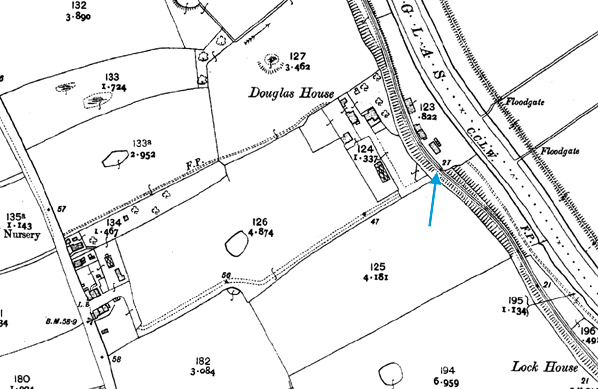|
Boat Yard Crossing Halt was towards the southern end of the 1¼-mile long Tarleton branch which connected to the West Lancashire Railway (WLR) Company’s Southport & Preston line at Hesketh Bank. The Tarleton branch was built by the WLR following the award of a tender on 17 October 1879. The branch was to connect the WLR line with Tarleton Lock at the northern end of the Leeds & Liverpool Canal’s Tarleton Branch; the lock connected the canal to the River Douglas which, in turn, led into the River Ribble. Construction of the line was due to start on 10 November 1879. It was easy to build on practically level land, with no bridges or tunnels, but there were five level crossings.
The Tarleton branch was built on land that the WLR did not own, and without an Act of Parliament. Three parties owned the land: Sir Thomas Fermor-Hesketh, Lord Lilford and the Leeds & Liverpool Canal Company. Initially the WLR had to pay fees to the landowners, but an Act passed on 3 June 1881 allowed them to purchase the land over which the branch passed. It came into effect on 3 September 1881 and should have conferred outright ownership the WLR. However it appears that some payments to the original landowners were not made, and in February 1895 a board minute records that Sir Thomas Fermor-Hesketh conveyed his share of the land free of charge to the company. A smaller portion of the land at Tarleton which was canal company land was not paid for and remained in their ownership.
The Preston Guardian of 31 July 1880 reported that the branch was in use and that a warehouse and wharves were provided at the Tarleton end of the branch – which was built for goods services only. The WLR owned five steam barges which operated from Liverpool to Tarleton via the Leeds & Liverpool Canal. Goods were transferred to rail at Tarleton then conveyed to Southport via the WLR line.
The WLR led a precarious existence and, after becoming insolvent, was absorbed by the Lancashire & Yorkshire Railway (LYR) on 1 July 1897. The LYR undertook a full survey of the WLR network and found it wanting. An LYR Board minute from 13 July 1897 described the Tarleton branch as being ‘in thoroughly bad condition; if loco use is intended then it will have to be re-laid’. Although the LYR carried out improvements to the former WLR main line it seems unlikely that they did anything on the Tarleton branch. It was recorded in an LYR minute dated 28 September 1898 that there was a proposal to close it with effect from 31 December 1898. The general manager stated that the Leeds & Liverpool Canal Company had no objection to the line closing. It was suggested that the LYR ‘may require a claim on the land and may keep the branch open by running one engine per year on it’. The decision was, however, deferred.
 |
In a minute from 12 October 1898, the proposed closure of the branch was mentioned once again ‘as the purpose of the branch re canal traffic is about to cease’. However the meeting heard that ‘the landowner adjoining the branch would in future be able to connect to the branch to connect with the LYR’. In the end it was decided to keep the branch open and spend £900 on repairs. On 6 November 1900 the LYR agreed to purchase the section of the branch that was owned by the canal company and had never been bought by the WLR.
It is likely that the branch remained moribund for the next decade as no records survive to show it had any traffic.
It gained a new lease of life when on 3 June 1912 the LYR introduced a ‘railmotor’ passenger service between Tarleton and Crossens, on the former WLR main line a few miles north of Southport. By this time electric services operated between Southport and Crossens, offering interchange opportunities. It was for the introduction of this service that Boat Yard Halt was constructed. As its name implies, the halt was adjacent to a boatyard, towards the southern end of the line at the top of a bank. The only other stopping place on the line, less than ¼-mile to south, was the terminus known as Tarleton Halt. The branch was inspected for passenger services by Colonel E Drewitt on 24 May 1912. His report recommended that a passenger service be allowed, and he described the halt at Boat Yard Crossing as being at rail level, with two oil lamps and a nameboard. Although not mentioned in the report, it is known that it had a basic low-level concrete platform only 3ft square and that it was north-east of the line. In the same report it was stated that initially the service would run in daylight hours only and must not exceed 15mph whilst on the branch.
The first service of the day started at Southport Chapel Street and the last one returned there, enabling the railmotor to set out from, and return to, Southport engine shed.
The railmotor service was not successful; after little more than a year it was discontinued on 1 October 1913. The Tarleton branch reverted to goods services only, although there is little evidence that any ran by this time. A 1925 track diagram showed the branch in situ but closed, and formal closure followed in 1930.
Route map drawn by Alan Young
Sources:
To see other stations Tarleton Branch and Served by the Railmotor Service click on the station name: Crossens, Banks, Hundred End, Hesketh Bank & Tarleton, & Tarleton
|

halt_old1.jpg)


halt1.jpg)
 Home
Page
Home
Page
